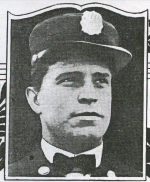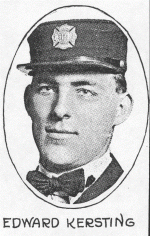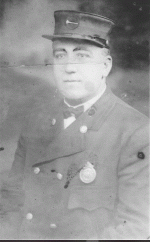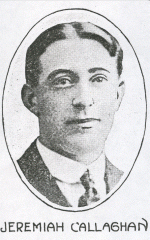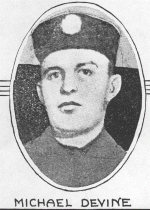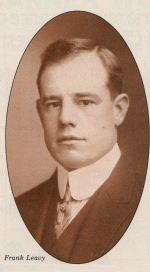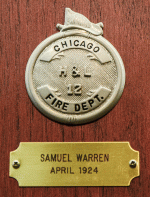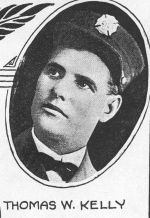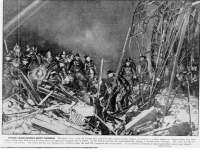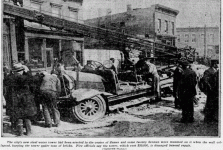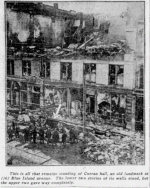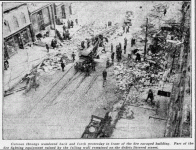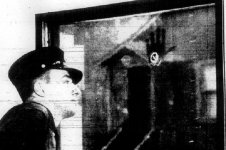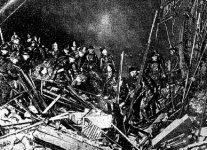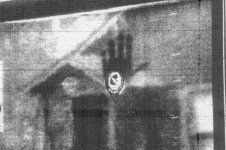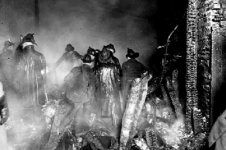Fire Service Line of Duty Deaths
April 18th,1924
Curran Hall fire
1363 S. Blue Island
Chicago, IL
8 Firemen killed
CAPTAIN JOHN BRENNAN OF ENGINE CO. 5
FIREMAN EDWARD KERSTING OF TRUCK CO. 12
FIREMAN FRANCIS LEAVY OF ENGINE CO. 107
LIEUTENANT FRANK FROSH OF TRUCK CO. 12
FIREMAN JEREMIAH CALLAGHAN OF TRUCK CO. 12
FIREMAN MICHAEL DEVINE OF ENGINE CO. 5
FIREMAN SAMUEL WARREN OF TRUCK CO. 12
FIREMAN THOMAS KELLY OF TRUCK CO. 12
In 1924, Good Friday fell on April 18. On that afternoon, members of the Chicago Fire Department's Engine Co. 107 and Truck Co. 12 settled into their daily routine. Even though it was a holy day, cleaning the large firehouse was still a necessary duty. After drawing the task of cleaning the first-floor windows, Francis X. Leavy, a member of Engine 107, set about his duties without any specific zeal.
At that particular moment in history, the world beyond the stable pattern of firehouse life was pursuing an unusually lively pace. Europe was still rebuilding from the Great War. In Paris, a lost generation of writers and artists was trying to make sense of it all. In America, the Roaring Twenties moved wildly to the playing of Benny Goodman and Louis Armstrong. It was the Jazz Age, an era of flappers and It Girls, of illegal liquor and underground speakeasies, of individual fortunes created by a skyrocketing stock market. Chicago was in the thick of the action, a Babylon of prostitution, gambling, and bootlegging thanks largely to its mayor and chief buffoon, William Hale "Big Bill" Thompson, who along with most city cops and county judges, was compensated handsomely by the underworld. In 1924, Chicago's Grant Park Stadium was renamed Soldier Field in honor of America's World War I veterans, and a reform mayor, William Devers, was elected after promising to clean things up. But four years later the crooked Thompson would be back in office, once again padding his pockets with the spoils of public corruption.
Frank Leavy and his Chicago Fire Department colleagues didn't share in the glamour of the era. As gangster Al Capone lived a potentate's existence in downtown Chicago hotel suites, city firemen struggled to raise families on about $2,500 a year. Most had to work second jobs. Frank Leavy spent his days off driving a taxi.
Like most of his co-workers, Leavy was Irish. He joined the fire department 13 years earlier after an eight-year stint in the navy, which he had joined at age 14. A family man, he and his wife Mary were parents of a young son and daughter, Frank, Jr. and June. When Leavy said goodbye that Good Friday morning, no one guessed it would be for the last time. All day, the normally upbeat Leavy seemed uncharacteristically sullen, even melancholy.
As the firemen went about their cleaning, they listened to the Joker, the telegraph system at the front of the firehouse that devoted most of that afternoon to a four-alarm fire in the Union Stockyards. The fire was too far away; Engine 107 and Truck 12 were not due to respond. Yet, that such a large fire was burning only a few miles to the south made the men edgy. Leavy tried putting it out of his mind, concentrating on the window he was washing. He placed his left hand against the glass and wiped it clean with a soapy sponge in his right hand. It was precisely at this moment that he looked down and uttered a grim prophecy:
"This is my last day on the fire department."
Though Leavy had spoken to no one in particular, his words, coupled with his sudden change in personality, puzzled his fellow firefighters, including Edward McKevitt, who had been standing next to him. Before McKevitt could respond, bells started ringing. Box 372 was coming in for a fire a mile-and-a-half east. Engine 107 and Truck 12 were due to cover the response because other fire companies stationed closer to the new fire were fighting the stockyards fire. "Fourteenth and Blue Island," yelled the officer at the desk. "Let's Go." Leavy donned his boots, coat, and helmet and jumped on the back of the 1921 Ahrens-Fox pumper assigned to Engine 107.
The fire was bad. Burning was Curran Hall, a landmark 50-year-old brick building at 1363 S. Blue Island, southwest of the Loop. During its heyday, the four-story dance hall had been a popular party spot. But thanks to time and Prohibition, instead of dancing and fun, the hall now was home to several small businesses, including a leather goods store.
Engine 107's crew stretched a hoseline up the fire escape and into the burning second floor. They crawled on hands and knees through the heat and blinding smoke, inching their way to the seat of the fire. In those days firefighters had no breathing apparatus, so they had to follow the hose and crawl back and forth to the door to grab a breath of fresh air. After playing water against the flames for about a half hour, it began to darken, but the firefighters could sense something was wrong. Their instincts were confirmed when fire commanders outside began frantically screaming for their men to get out of the building.
But the warning came too late because no sooner did the men from Engine 107 and Truck 12 begin scrambling for the fire escape when the building's outer walls buckled, bringing down the entire structure, burying the firefighters inside. The collapse knocked out electrical power to the area, leaving those searching for trapped men to use flashlights. For several hours they dug by hand amid the possibility of a secondary collapse. When cranes were finally brought in eight bodies were dug out. Frank Leavy's dire prophecy had been fulfilled: he had been among those killed. Though Leavy's chest had been severely crushed, his was the only body recovered with an intact face, its features clearly distinguishable.
Of the eight dead firefighters, six were from the firehouse at 13th and Oakley. One civilian had also been killed. A ninth firefighter, also from the Oakley station, died eight days later. Twenty others had been injured. A tenth firefighter suffered a fatal heart attack while serving as a pallbearer for one of the victims from Truck 12.
When the building collapsed, Edward McKevitt was working outside. The next day, the shaken McKevitt related to a group of firefighters Leavy's spooky premonition of death. As he told the story, McKevitt glanced up at the window Leavy had been wiping. Etched in the glass, in the exact spot where Leavy had rested his soapy left hand was the image of a man's handprint. Because it hadn't been there before, McKevitt suggested the handprint was Leavy's, and he and the others tried scrubbing it away. When the image refused to come off, a combination of fear and mystery infiltrated the firehouse.
Arson surfaced during the investigation of the Curran Hall fire. Flammable liquids had been used to start the fire, which originated inside the leather goods store on the second floor. Detectives learned that the store's two owners had been in financial trouble, and that on the night of the fire, the pair had instructed their employees not to lock the rear doors. Witnesses later related seeing one of the men leave the building through the unlocked door shortly before the fire was reported. After a coroner's jury returned a verdict of murder by arson, the two owners were indicted. At trial the defendants were acquitted because, despite an abundance of circumstantial evidence, nothing could be produced to prove that they had actually started the fire themselves. For the dead firefighters and their families, this meant justice had been denied.
Meanwhile, the legend of the ghostly handprint lived on. Over the years, firefighters assigned to Engine 107 and Truck 12 came and went. But in the course of their daily house duties, many had tried to scrub the mysterious handprint from the window. Not one effort, including the use of ammonia or scraping the glass with a razor blade, had succeeded. Finally, the Pittsburgh Glass Company, which had manufactured the window, was called in. Still, the apparently supernatural print resisted even their toughest chemical cleaning compounds, causing the handprint to become all the more famous. Dozens of people visited the firehouse to view the strange phenomenon and listen to the story of Frank Leavy. Was the handprint an apparition? No one knew for sure. But when a city official obtained a copy of Leavy's thumb-print, it was compared with the print on the window. The two thumbprints matched perfectly. There could be no doubt: the handprint on the glass definitely belonged to Frank Leavy.
The handprint remained undisturbed for 20 years until one day in 1944, when the unexplained revisited the firehouse at 13th and Oakley. A newsboy accidentally threw the afternoon paper through the window, shattering the glass containing the handprint along with any hope of solving its mystery or preserving its physical evidence. What made the accident eerie was the date of its occurrence: April 18, 1944, exactly 20 years to the day of Leavy's death.
Leavy's widow, Mary, and her daughter, June, never went to the firehouse to view the handprint. The younger Frank Leavy did, though he never conceded that the print was his father's. Yet, he did follow in his father's footsteps by joining the Chicago Fire Department on April 18, 1945, the 21st anniversary of his father's death. He was not assigned to Engine 107.
Aside from the belief that the handprint was supernatural, some have theorized that Frank Leavy's fear of an impending crisis may have caused his pancreas to produce a chemical that left behind a permanent stain through his perspiration. No one will ever know for sure. The firehouse at 13th and Oakley was razed in 1971, replaced by a newer one a few blocks away.
RIP. Never forget.
April 18th,1924
Curran Hall fire
1363 S. Blue Island
Chicago, IL
8 Firemen killed
CAPTAIN JOHN BRENNAN OF ENGINE CO. 5
FIREMAN EDWARD KERSTING OF TRUCK CO. 12
FIREMAN FRANCIS LEAVY OF ENGINE CO. 107
LIEUTENANT FRANK FROSH OF TRUCK CO. 12
FIREMAN JEREMIAH CALLAGHAN OF TRUCK CO. 12
FIREMAN MICHAEL DEVINE OF ENGINE CO. 5
FIREMAN SAMUEL WARREN OF TRUCK CO. 12
FIREMAN THOMAS KELLY OF TRUCK CO. 12
In 1924, Good Friday fell on April 18. On that afternoon, members of the Chicago Fire Department's Engine Co. 107 and Truck Co. 12 settled into their daily routine. Even though it was a holy day, cleaning the large firehouse was still a necessary duty. After drawing the task of cleaning the first-floor windows, Francis X. Leavy, a member of Engine 107, set about his duties without any specific zeal.
At that particular moment in history, the world beyond the stable pattern of firehouse life was pursuing an unusually lively pace. Europe was still rebuilding from the Great War. In Paris, a lost generation of writers and artists was trying to make sense of it all. In America, the Roaring Twenties moved wildly to the playing of Benny Goodman and Louis Armstrong. It was the Jazz Age, an era of flappers and It Girls, of illegal liquor and underground speakeasies, of individual fortunes created by a skyrocketing stock market. Chicago was in the thick of the action, a Babylon of prostitution, gambling, and bootlegging thanks largely to its mayor and chief buffoon, William Hale "Big Bill" Thompson, who along with most city cops and county judges, was compensated handsomely by the underworld. In 1924, Chicago's Grant Park Stadium was renamed Soldier Field in honor of America's World War I veterans, and a reform mayor, William Devers, was elected after promising to clean things up. But four years later the crooked Thompson would be back in office, once again padding his pockets with the spoils of public corruption.
Frank Leavy and his Chicago Fire Department colleagues didn't share in the glamour of the era. As gangster Al Capone lived a potentate's existence in downtown Chicago hotel suites, city firemen struggled to raise families on about $2,500 a year. Most had to work second jobs. Frank Leavy spent his days off driving a taxi.
Like most of his co-workers, Leavy was Irish. He joined the fire department 13 years earlier after an eight-year stint in the navy, which he had joined at age 14. A family man, he and his wife Mary were parents of a young son and daughter, Frank, Jr. and June. When Leavy said goodbye that Good Friday morning, no one guessed it would be for the last time. All day, the normally upbeat Leavy seemed uncharacteristically sullen, even melancholy.
As the firemen went about their cleaning, they listened to the Joker, the telegraph system at the front of the firehouse that devoted most of that afternoon to a four-alarm fire in the Union Stockyards. The fire was too far away; Engine 107 and Truck 12 were not due to respond. Yet, that such a large fire was burning only a few miles to the south made the men edgy. Leavy tried putting it out of his mind, concentrating on the window he was washing. He placed his left hand against the glass and wiped it clean with a soapy sponge in his right hand. It was precisely at this moment that he looked down and uttered a grim prophecy:
"This is my last day on the fire department."
Though Leavy had spoken to no one in particular, his words, coupled with his sudden change in personality, puzzled his fellow firefighters, including Edward McKevitt, who had been standing next to him. Before McKevitt could respond, bells started ringing. Box 372 was coming in for a fire a mile-and-a-half east. Engine 107 and Truck 12 were due to cover the response because other fire companies stationed closer to the new fire were fighting the stockyards fire. "Fourteenth and Blue Island," yelled the officer at the desk. "Let's Go." Leavy donned his boots, coat, and helmet and jumped on the back of the 1921 Ahrens-Fox pumper assigned to Engine 107.
The fire was bad. Burning was Curran Hall, a landmark 50-year-old brick building at 1363 S. Blue Island, southwest of the Loop. During its heyday, the four-story dance hall had been a popular party spot. But thanks to time and Prohibition, instead of dancing and fun, the hall now was home to several small businesses, including a leather goods store.
Engine 107's crew stretched a hoseline up the fire escape and into the burning second floor. They crawled on hands and knees through the heat and blinding smoke, inching their way to the seat of the fire. In those days firefighters had no breathing apparatus, so they had to follow the hose and crawl back and forth to the door to grab a breath of fresh air. After playing water against the flames for about a half hour, it began to darken, but the firefighters could sense something was wrong. Their instincts were confirmed when fire commanders outside began frantically screaming for their men to get out of the building.
But the warning came too late because no sooner did the men from Engine 107 and Truck 12 begin scrambling for the fire escape when the building's outer walls buckled, bringing down the entire structure, burying the firefighters inside. The collapse knocked out electrical power to the area, leaving those searching for trapped men to use flashlights. For several hours they dug by hand amid the possibility of a secondary collapse. When cranes were finally brought in eight bodies were dug out. Frank Leavy's dire prophecy had been fulfilled: he had been among those killed. Though Leavy's chest had been severely crushed, his was the only body recovered with an intact face, its features clearly distinguishable.
Of the eight dead firefighters, six were from the firehouse at 13th and Oakley. One civilian had also been killed. A ninth firefighter, also from the Oakley station, died eight days later. Twenty others had been injured. A tenth firefighter suffered a fatal heart attack while serving as a pallbearer for one of the victims from Truck 12.
When the building collapsed, Edward McKevitt was working outside. The next day, the shaken McKevitt related to a group of firefighters Leavy's spooky premonition of death. As he told the story, McKevitt glanced up at the window Leavy had been wiping. Etched in the glass, in the exact spot where Leavy had rested his soapy left hand was the image of a man's handprint. Because it hadn't been there before, McKevitt suggested the handprint was Leavy's, and he and the others tried scrubbing it away. When the image refused to come off, a combination of fear and mystery infiltrated the firehouse.
Arson surfaced during the investigation of the Curran Hall fire. Flammable liquids had been used to start the fire, which originated inside the leather goods store on the second floor. Detectives learned that the store's two owners had been in financial trouble, and that on the night of the fire, the pair had instructed their employees not to lock the rear doors. Witnesses later related seeing one of the men leave the building through the unlocked door shortly before the fire was reported. After a coroner's jury returned a verdict of murder by arson, the two owners were indicted. At trial the defendants were acquitted because, despite an abundance of circumstantial evidence, nothing could be produced to prove that they had actually started the fire themselves. For the dead firefighters and their families, this meant justice had been denied.
Meanwhile, the legend of the ghostly handprint lived on. Over the years, firefighters assigned to Engine 107 and Truck 12 came and went. But in the course of their daily house duties, many had tried to scrub the mysterious handprint from the window. Not one effort, including the use of ammonia or scraping the glass with a razor blade, had succeeded. Finally, the Pittsburgh Glass Company, which had manufactured the window, was called in. Still, the apparently supernatural print resisted even their toughest chemical cleaning compounds, causing the handprint to become all the more famous. Dozens of people visited the firehouse to view the strange phenomenon and listen to the story of Frank Leavy. Was the handprint an apparition? No one knew for sure. But when a city official obtained a copy of Leavy's thumb-print, it was compared with the print on the window. The two thumbprints matched perfectly. There could be no doubt: the handprint on the glass definitely belonged to Frank Leavy.
The handprint remained undisturbed for 20 years until one day in 1944, when the unexplained revisited the firehouse at 13th and Oakley. A newsboy accidentally threw the afternoon paper through the window, shattering the glass containing the handprint along with any hope of solving its mystery or preserving its physical evidence. What made the accident eerie was the date of its occurrence: April 18, 1944, exactly 20 years to the day of Leavy's death.
Leavy's widow, Mary, and her daughter, June, never went to the firehouse to view the handprint. The younger Frank Leavy did, though he never conceded that the print was his father's. Yet, he did follow in his father's footsteps by joining the Chicago Fire Department on April 18, 1945, the 21st anniversary of his father's death. He was not assigned to Engine 107.
Aside from the belief that the handprint was supernatural, some have theorized that Frank Leavy's fear of an impending crisis may have caused his pancreas to produce a chemical that left behind a permanent stain through his perspiration. No one will ever know for sure. The firehouse at 13th and Oakley was razed in 1971, replaced by a newer one a few blocks away.
RIP. Never forget.
Last edited:

